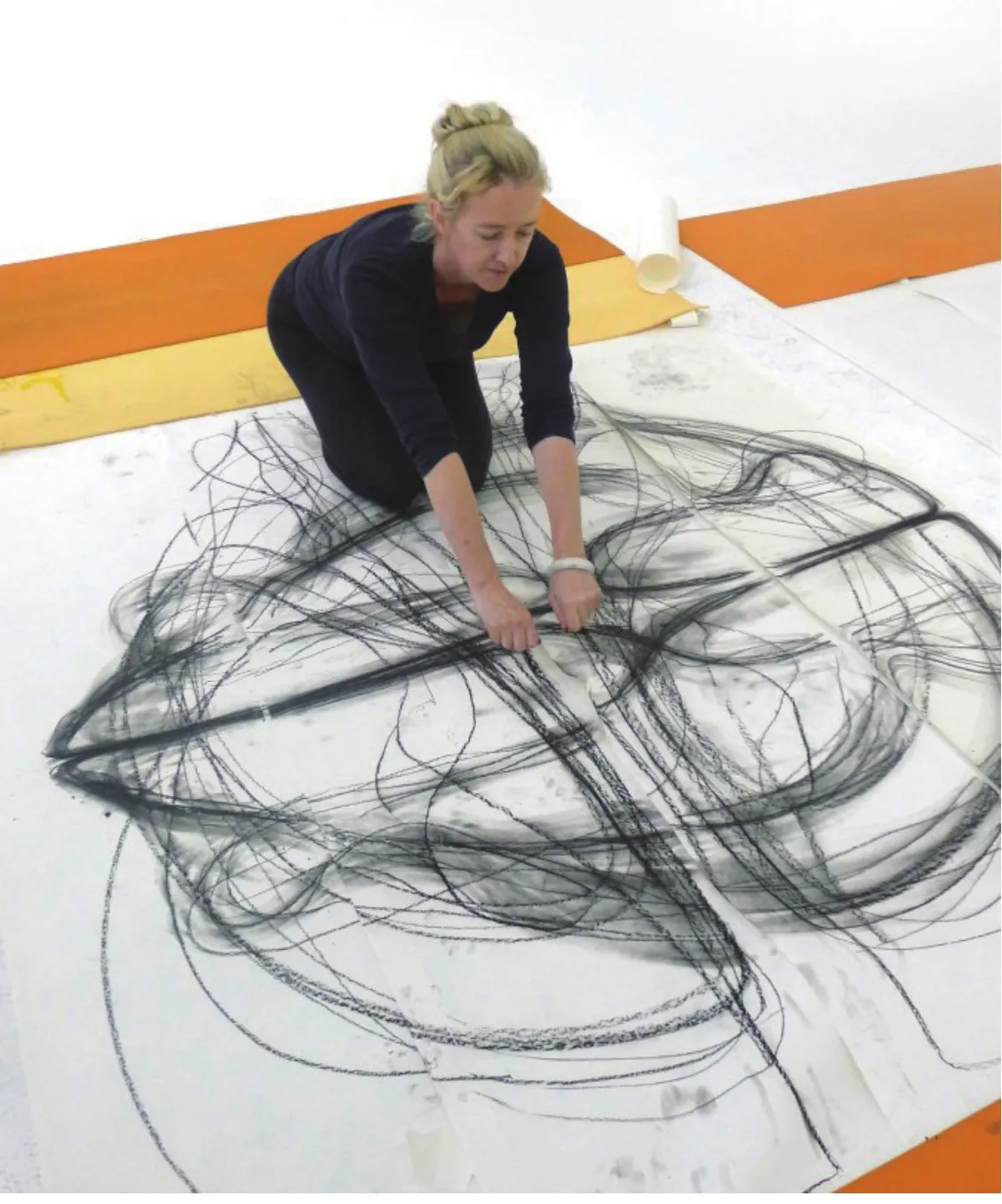在北京的爱尔兰艺术家
2016-12-02ByTracieBarrett
By Tracie Barrett
在北京的爱尔兰艺术家
Irish Artist in Beijing
By Tracie Barrett

爱尔兰艺术家尼亚芙·坎宁安以编织和绘画的方式,把她的私人物品和周遭事物都融入进了她的艺术作品里。
走进尼亚芙·坎宁安位于北京的公寓,首先映入眼帘的是那满墙的油画。进一步研究便会发现,这些画风格各异,主题丰富,不管远观还是近看都让人印象深刻——由深红和黑色轮廓构成的是以地铁为主题的一组油画,一幅巨大的山景图上用厚涂颜料绘出了崎岖的峭壁,还有一幅幅肖像画的线条柔和得就像快融化了一样,这些肖像画的灵感来自中国当代艺术家张德龙的作品。
不过,这位出生在都柏林的艺术家的创作并不局限于油画。走进她的工作室或登录她的网站,你会看到一个用她自己的头发编成的精致头骨。还有一个编织的螺旋柱,看上去比头骨更结实,它的作用相当于日历,它既记录世界上发生的大事,也记录个人成长的小事。一谈起她待过的国家,旅行过的地方,还有自己是怎么成为艺术家时,坎宁安那温和的爱尔兰口音便会交织出时而飘渺时而具体的画面,这些话语本身就像艺术品一样。
From knitting to painting, Irish artist weaves her heritage and surroundings into her art, as Tracie Barrett discovers.
The first thing one notices on entering the Beijing apartment of artist Niamh Cunningham is the number of canvases covering almost every inch of wall space. A closer look shows an equally impressive variety of styles and subject matter - the dark reds and black silhouettes of her subway series, thickly applied impasto oils that form rugged crags on a huge mountains cape, and the soft, seemingly melting lines of her Transparent Milk portraits, inspired by the work of the contemporary Chinese artist Zhang Delong.
Nor does the Dublin-born artist limit herself to working on canvas. Stepping into her studio or browsing her website, one can see a delicate knitted skull spun from her own hair and a more solid knitted spiral that serves as a calendar, both public and very personal. Cunningham’s speech is an artwork of its own, her soft Irish brogue weaving ethereal and elemental images, as she speaks of the countries in which she has lived and traveled and her evolution as an artist.
Surprisingly, or perhaps not when one sees the detail in her work, Cunningham studied biomedical sciences at university and has both a bachelor’s and a master’s degree in the field. Art has always been part of her life, however, learned first from her mother and grandmother and honed through practice and experimentation.
“My gran was a painter,” she says, “So she gave me my first oils when I was 11. My mother used to make marmalade from real oranges and when the crates of oranges came, there was a canvas board on the crates.”
Her grandmother, a “hobbyist” painter, taught her how to prime the boards and they were her first canvases.
令人惊讶的是,坎宁安在大学读的是生物医学,并且拿到了生物医学的本科和硕士学位,这也许可以从她的作品细节中看出。艺术一直是她生活的一部分。然而,她最初是从母亲和祖母那里学来的,后来,通过反复实践和尝试,她变得越来越得心应手。
“我的祖母是个画家。”坎宁安说,“我11岁的时候,她第一次给了我油画颜料。我母亲原来是做橘子酱的,每次有成箱的橘子运来,箱子上都会盖着一块帆布板。”
坎宁安的祖母是一个“嗜画成瘾”的画家,她教会了坎宁安如何利用这些帆布板,这些板成了她最早的油画板。
在坎宁安专心于生物医学期间,艺术被她丢在了一边。一开始在英国,她与她现在的丈夫相遇。后来她去了南非的约翰内斯堡,在当地的一所学院教授医学实验科学。在那里,她跟艺术系的老师们建立了友谊,并借此机会再次开始尝试自己的艺术创作,她说她总是会把丙烯酸颜料画和南非联系起来。
一个地方与艺术作品之间的联系,是坎宁安变化多样的作品里永恒的主题,她说自己的艺术作品是自己对置身之地的“明确回应”。
离开南非之后,她在香港待了7年,于1991年生下了儿子芬恩(Fionn),此后她又去东京呆了3年。后来,全家搬到迪拜住了5年。坎宁安说,迪拜是她的“最初作品的题材来源”。
一家人住得离迪拜河不远,她几乎每天都带着儿子去河边散步,潺潺的河水成了她迪拜风光画的主题。
她说:“就是在那时候,我意识到自己应该成为一名认真专一的画家,至少,我意识到我该放下我的教学工作了。”
她在迪拜举办了两次个人展览,然后一家人回到爱尔兰,在那儿待了一年。这样芬恩便可以体验那里的生活,“知道他是爱尔兰人”。从那个时期起她的作品便开始描绘祖国的大好河山。
接下来的一年是在布拉格度过的,在那里她创作了一系列风景图,描绘着这座历史名城里的屋顶和桥梁。然后,大约6年前,全家人搬到了北京,在这里,坎宁安再次开始描绘美丽的风景,也找回了童年在纺织品上绘图的激情。
她说:“我在读小学的时候,只有一件事让我觉得超级自信,也只有这件事让我觉得我比学校的任何人都强,那就是编织。这是母亲遗传给我的东西之一。”
她说她“大量想法”的灵感都来自于北京,包括描绘城市公共交通和自行车这一“慢速芭蕾”的作品系列,大大小小的车子拥挤在一起“像一群蜜蜂或其他什么昆虫”。
她说:“我认为,如果你有机会为一个展览创作一些新作品,这能很自然地把你推向一个未知领域。”
Art fell by the wayside as she pursued a career in the medical field, first in England where she met her husband and then in Johannesburg, South Africa, where she taught Medical Lab Sciences at a local college. There, through friendships she made with staff in the art department, she started experimenting with her own art again and she says she will always associate South Africa with acrylics.
The connection between place and artwork is a constant in her diverse body of work, as she says her art is “definitely a response” to where she is.
Her time in South Africa was followed by seven years in Hong Kong, where her son Fionn was born in 1999, and three in Tokyo. The family then moved to Dubai for five years, and Cunningham said that is where her “first main body of work came”.
The family lived close to the Dubai Creek and she took Fionn walking there almost every day, its rippling waters becoming the lifeblood of her Dubai cityscapes.
“That’s when I knew I would be a very serious painter, or at least I knew I would have to drop my teaching.” she says.
She had two solo shows while in Dubai, then the family returned to Ireland for a year, so Fionn could experience living there and “know he was Irish”. Her work from that period portrays the rich emerald beauty of her homeland.
The next year was spent in Prague, resulting in another series of landscapes, featuring the rooftops and bridges of the historic city. Then, almost six years ago, the family relocated to Beijing, where Cunningham has again painted stunning landscapes, but also returned to a childhood passion for working with textiles.
“When I was in primary school, the only thing I felt super confident in doing, the only thing I was better at than anyone else in school was knitting and sewing,” she says, “It was one of the legacies my mother handed to me.”
She says she has “loads of ideas” inspired by Beijing, including a series about the city’s public transport and the “slow ballet” of bicycles - “almost like a swarm of bees or insects”.
“I think if you have an opportunity to make new work for an exhibition, it’s natural to push yourself into unknown directions.” she says.
